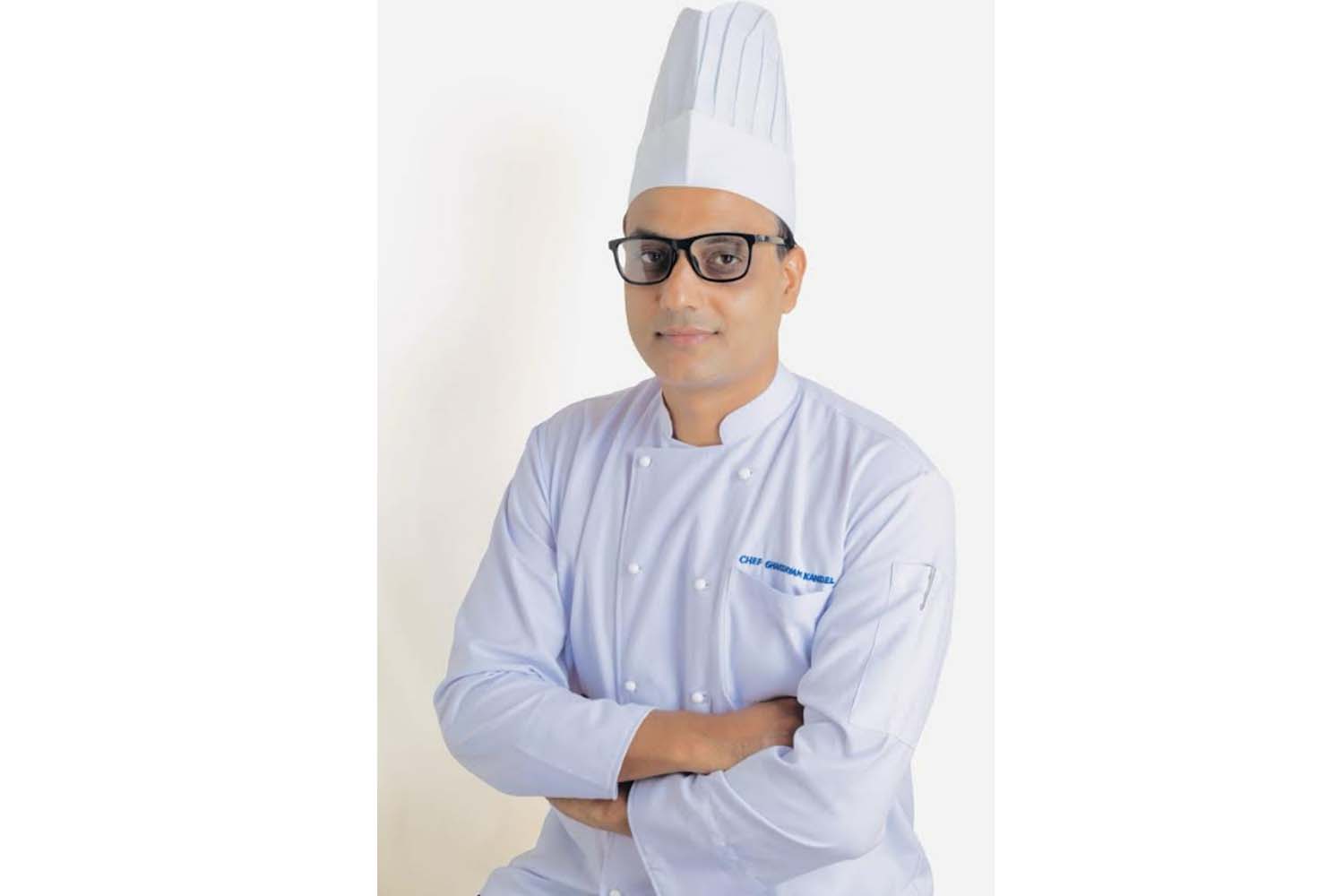Culture & Lifestyle
Blending cultures, one dish at a time
A self-taught chef, entrepreneur, and author, Ghanashyam Kandel discusses his vision for globalising Nepali cuisine.
Aarya Chand
Chef Ghanashyam Kandel’s culinary journey spans three countries: Nepal, India, and Japan. Over the past thirty years, he has combined traditional Nepali flavours with international cuisines.
In a conversation with the Post’s Aarya Chand, Chef Kandel shares his journey from limited educational opportunities in Nepal to becoming a culinary entrepreneur. He discusses his vision for globalising Nepali cuisine, his recently launched cookbook ‘Timur’, and his upcoming book, ‘Bhojan Lipi’.
Tell us about your early life and how you started your culinary journey.
I grew up and completed my primary education in Baglung. However, my family’s circumstances and inadequate educational facilities prevented me from continuing my studies. My elder brother was already working as a chef in India, and since I had a keen interest in cooking from a young age, I decided to follow in his footsteps.
In 1995, I travelled to India and trained under my brother for a year and a half. I worked in the country until 2000, primarily focusing on Indian-Nepali cuisine. After returning to Nepal, I continued working in various establishments until 2007, when I relocated to Japan.
For the past 18 years, I have worked in Japan, opening my own company, GK Corporation, and several restaurants. I am currently the Executive CEO and head chef of my restaurant, which specialises in Indian, Nepali, and Thai fusion cuisine.
What inspired you to pursue a career in cooking?
My elder brother was a key influence. I didn’t have access to cooking shows or master chef programmes, so I learned everything through experience. I also completed a one-year course in hospitality management. My brother later returned to Nepal and worked at the Hyatt Regency for eight years, further encouraging me.
Practical learning is more effective than theoretical knowledge, so I taught myself the necessary skills. Over time, I realised I wanted to share my knowledge with the next generation, which led me to write my cookbook, ‘Timur’.
Why did you choose Japan for your culinary career?
Many Nepali chefs travel to Dubai for international exposure. However, I opted for Japan since most of my friends were already there, and they recommended it for its stable working environment. Although I hadn’t initially focused on Japan, I chose to go when I received my first job offer. It turned out to be an excellent decision, as Japan enabled me to grow professionally and personally.
How have your experiences in Nepal, India, and Japan shaped your approach to cooking?
My culinary approach is grounded in hard work, honesty, and patience. I utilise locally sourced ingredients and adapt dishes to incorporate native flavours while preserving their heritage. My time in India enabled me to prepare Indian cuisine, and my experience in Japan allowed me to experiment with fusion dishes, blending Nepali, Indian, and Thai flavours. I also believe in sharing knowledge with others, so I have been teaching and mentoring aspiring chefs.
Can you tell us about your cookbook, ‘Timur’? What inspired you to write it, and how did you choose the title?
‘Timur’ embodies my 30 years of experience in the culinary field. The title derives from the Nepali spice timur, which is found across all three regions of Nepal and symbolises the diversity of Nepali cuisine. The book features a contemporary fusion of Thai, Japanese, and Nepali dishes. I aimed to create a cookbook that showcases traditional recipes and introduces innovative dishes that appeal to international audiences.
The book was launched on 30 December 2024 in Thamel, Kathmandu.
How did you select the recipes for ‘Timur’? Are they personal favourites or regional specialities?
The recipes in ‘Timur’ are a mix of my personal favourites and regional specialities. I chose dishes I believed would be delicious and accessible to home cooks. My goal was to create a cookbook that could inspire others to explore Nepali cuisine and experiment with fusion cooking.
What challenges did you face while writing Timur?
One of the main challenges was translating the book from Nepali to English, which took a lot of time. Additionally, I faced health issues during the process, including a severe case of food poisoning that required hospitalisation. This incident motivated me to write about food safety and hygiene, an essential aspect of the book.
Are there any underappreciated Nepali ingredients or dishes you feel deserve more recognition?
Yes, dishes like Gundruk (fermented leafy greens) are often overlooked. I’ve tried to modernise such dishes in my restaurant, such as creating Nepali Gundruk Taco and Garlic Chicken Masala, which have become very popular among my customers in Japan.

Can you share a personal story or memory of one of the dishes in ‘Timur’?
Among the dishes in the book, Garlic Chicken Masala stands out as one of my favourites. My customers, especially from abroad, love it. This dish symbolises my journey of merging traditional Nepali flavours with contemporary cooking methods.
How do you see the role of traditional Nepali cuisine evolving in the modern culinary world?
Traditional Nepali cuisine, like Thai or Indian dishes, could achieve international acclaim. By merging traditional flavours with contemporary presentations and methods, we can enhance its appeal to a global audience. My forthcoming book, ‘Bhojan Lipi’, which I co-authored with Chef Durga Khadka, aims to elevate Nepali cuisine worldwide.
Can you share some of the innovative dishes you’ve created?
Some of my innovative dishes include Gundruk Taco, Sisno Dhido with Lamb Chops, Sekuwako Bito, Garlic Chicken Masala, Naan Pizza, and Rainbow Momo (made with natural colours like saffron, turmeric, and beetroot). These dishes blend traditional Nepali flavours with modern techniques.
What are your hopes for how readers will connect with ‘Timur’?
I’ve written ‘Timur’ in a simple, step-by-step format so that even beginners can easily follow the recipes. I hope readers will try the dishes and feel inspired to experiment with their creations. I aim to make Nepali cuisine accessible to everyone, from home cooks to professional chefs.
Through ‘Timur’, I hope to unite people by sharing Nepal’s rich culinary heritage. I want to create a sense of community among home cooks and chefs, encouraging them to explore and celebrate Nepali cuisine.
How do you balance tradition and innovation in your cooking?
I am committed to maintaining the authenticity of traditional Nepali cuisine while blending modern techniques and global flavours. This strategy enables me to craft dishes that respect our cultural heritage and resonate with a worldwide audience. For instance, I’ve creatively incorporated traditional ingredients like Gundruk into tacos and salads.
What is your ultimate goal as a chef?
I aim to help elevate the recognition of Nepali cuisine on an international stage and inspire the next generation of chefs to innovate whilst remaining true to their roots. I wish to share my knowledge through cookbooks, teaching, and mentoring, ensuring Nepali cuisine deserves recognition.
Do you think Nepal needs more cooking shows to promote its cuisine and chefs?
Yes, I believe more cooking shows like MasterChef would benefit Nepal. Such platforms can inspire young chefs and facilitate culinary innovation. I hope to see more productions that showcase Nepali cuisine and encourage innovation in the field.
What advice would you give aspiring chefs who want to promote their native culinary traditions?
My advice is to be honest, patient, and diligent. Learn the fundamentals of your native cuisine thoroughly before experimenting with fusion dishes. Always be prepared to share your knowledge with others, as this will help elevate the culinary profession in your country. Lastly, never cease learning and evolving as a chef.




 17.12°C Kathmandu
17.12°C Kathmandu














